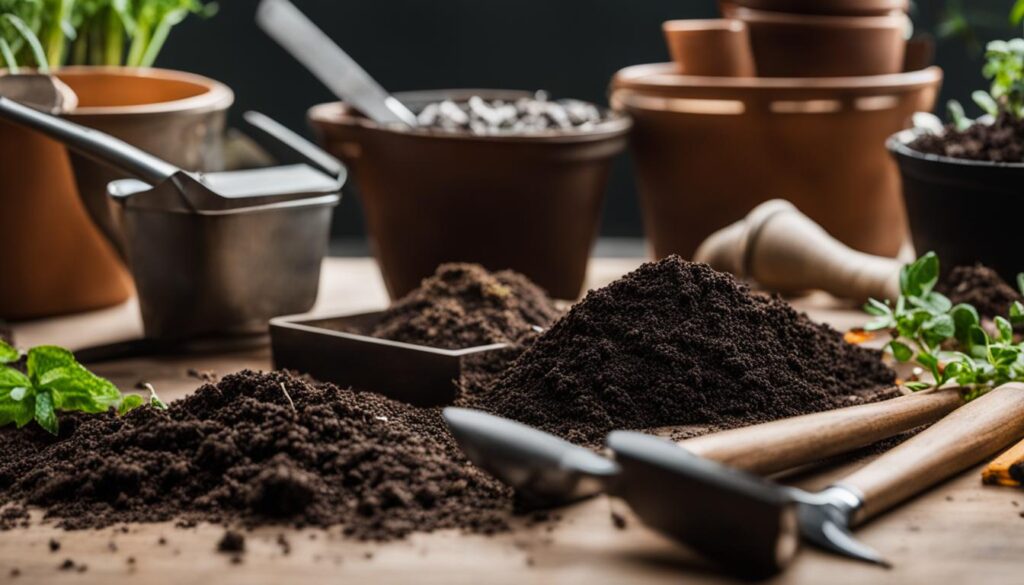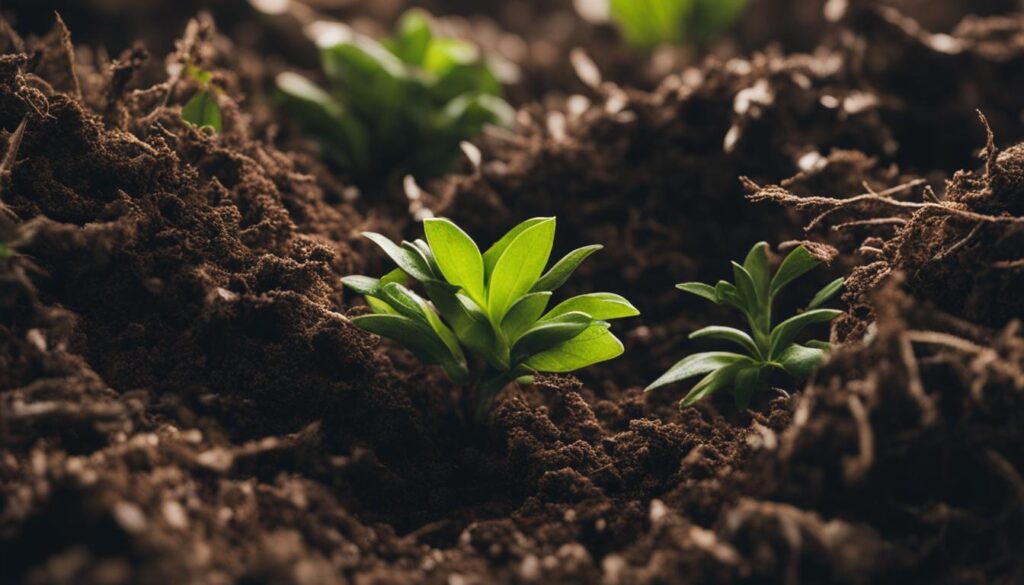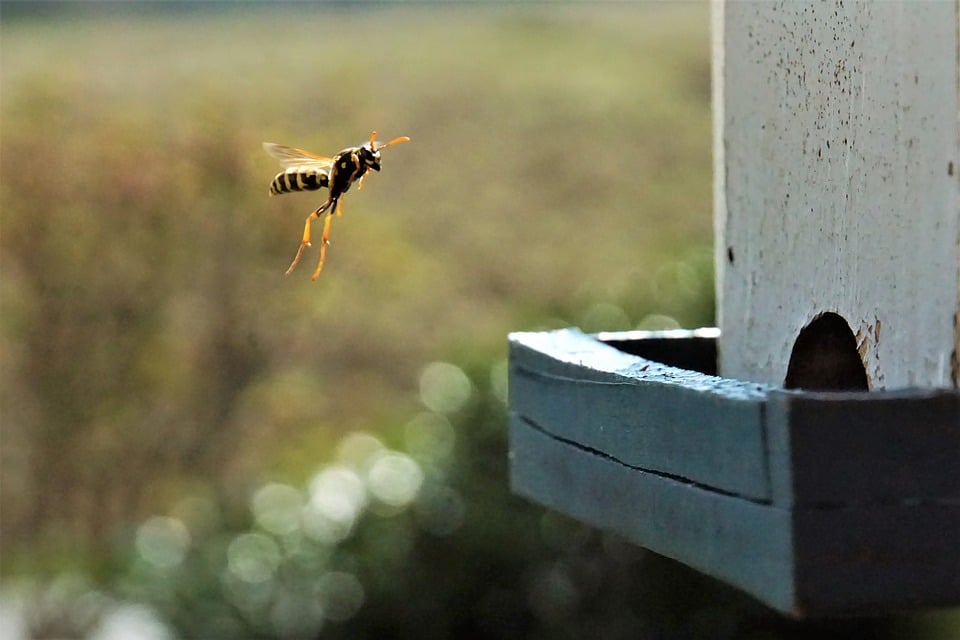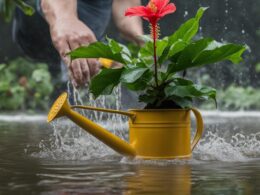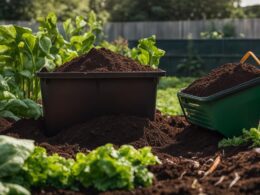Composting old potting soil is a sustainable practice that has numerous benefits for your garden. By adding soil to your compost bin, you provide a compost activator and inoculant, which help expedite the decomposition process and improve the quality of the finished compost. Soil also helps address common composting challenges such as foul smells and insect infestations. Moreover, it speeds up the composting process and improves the texture and composition of the finished compost. Whether you use loam, potting soil, or clay soil, adding a small amount of soil to your compost bin can greatly enhance its productivity.
Post Summary:
- Composting old potting soil benefits your garden and promotes sustainable gardening practices.
- Adding soil to your compost bin improves compost quality and helps address common composting challenges.
- Soil acts as a compost activator and inoculant, expediting decomposition and creating a thriving environment for beneficial microorganisms.
- Choosing the right type of soil for composting depends on your garden’s specific needs.
- Adding the right amount of soil, approximately 10% by volume, ensures optimal composting results.
The Wonder of Soil Life: Why Should We Add Soil to Compost?
Soil is more than just dirt; it is a living ecosystem teeming with microorganisms and bugs that play a crucial role in the composting process. When you add soil to your compost, you introduce a diverse community of beneficial organisms that act as compost activators and inoculants.
These microorganisms, such as bacteria, fungi, and protozoa, break down organic matter, releasing essential nutrients and creating a nutrient-rich compost. They also help control the temperature and moisture levels in the compost pile, ensuring optimal conditions for decomposition.
By incorporating soil into your compost, you create a thriving environment for these microorganisms, allowing them to multiply and accelerate the decomposition process. This results in faster composting times and higher-quality finished compost.
“Adding soil to your compost is like adding fuel to a fire. It ignites the composting process and fuels the growth of beneficial organisms.” – Expert Gardener
Additionally, soil helps improve the structure and texture of the finished compost. It aids in creating a well-balanced compost that is crumbly, moisture-retentive, and full of essential nutrients. The addition of soil also helps address common composting challenges, such as foul smells and insect infestations, by introducing a balance of beneficial bacteria that neutralize odors and act as a barrier against pests.
The Benefits of Adding Soil to Compost:
- Accelerates the composting process
- Improves the quality and structure of the finished compost
- Controls temperature and moisture levels in the compost pile
- Enhances nutrient availability for plants
- Addresses common composting challenges, such as foul smells and insects
| Beneficial Soil Organisms | Role in Composting |
|---|---|
| Bacteria | Break down organic matter and release nutrients |
| Fungi | Decompose tough plant materials, create stable humus |
| Protozoa | Consume bacteria and release nutrients as waste |
| Earthworms | Aerate the compost pile and break down organic matter |
Coping with Common Composting Challenges
Composting can sometimes present challenges, such as foul smells and insect infestations, that can deter even the most seasoned gardeners. However, with the addition of soil to your composting routine, you can effectively address and overcome these common issues. Soil acts as a natural solution, introducing a balance of beneficial bacteria that neutralizes bad odors and acts as a barrier against fruit flies and ants, preventing them from accessing the compost material. By simply adding a layer of topsoil to your compost bin, you can eliminate these challenges and create a healthier composting environment.
One of the main reasons compost piles develop unpleasant odors is due to an imbalance in the carbon-to-nitrogen ratio, which can lead to anaerobic conditions. Adding soil to your compost helps restore this balance and promotes aerobic decomposition, reducing foul smells in the process.
Insect infestations can also be a nuisance when composting, especially when fruit flies and ants are attracted to decomposing food scraps. By incorporating soil into your compost, you create a physical barrier that deters these pests from accessing the organic material. The soil also provides a home for beneficial microorganisms that compete for resources with harmful insects, further reducing their presence in your compost pile.
| Challenge | Solution |
|---|---|
| Foul smells | Add soil to restore carbon-to-nitrogen balance and promote aerobic decomposition. |
| Insect infestations | Incorporate soil as a physical barrier and habitat for beneficial microorganisms to deter pests. |
By addressing these common composting challenges with the addition of soil, you can create an environment that supports the efficient decomposition of organic material and ultimately yields nutrient-rich compost for your garden. So don’t let foul smells and insects discourage you from composting – a little soil can go a long way in creating a successful composting experience.
Choosing the Right Type of Soil for Composting
When it comes to composting, choosing the right type of soil is crucial for creating nutrient-rich organic matter. Different types of soil offer unique benefits that can enhance the composting process and improve the quality of the finished compost. Here are some key considerations to keep in mind when selecting the soil for your compost pile:
Loam Soil:
Loam soil is often regarded as the ideal choice for composting. It is a well-balanced soil that contains the right mixture of sand, silt, clay, and organic matter. Loam soil provides excellent drainage, retains moisture, and contains a rich array of beneficial microorganisms. Adding loam soil to your compost pile helps create a fertile environment for decomposition and produces nutrient-rich compost.
Potting Soil:
Potting soil, especially old potting soil, can also be beneficial for composting. It contains a mix of organic matter, such as peat moss, vermiculite, and perlite, which adds valuable nutrients to the compost pile. However, it’s important to ensure that the potting soil doesn’t contain any artificial additives or excessive rocks or pebbles that may hinder the composting process.
Clay Soil:
Clay soil can be a valuable addition to the compost pile, particularly for its moisture retention properties. Clay soil has the ability to hold water, preventing excessive drying of the compost pile. By incorporating clay soil into your compost, you can help maintain adequate moisture levels and ensure that the decomposition process proceeds smoothly.
Remember, regardless of the type of soil you choose, it’s important to avoid using soil that has been treated with harmful chemicals or pesticides. Opt for organic, untreated soil for the best results.
How Much Soil should You Add to Compost?
Adding soil to your compost is a great way to enhance the composting process and achieve optimal results. However, it’s important to strike the right balance and not overdo it. As a general guideline, it is recommended to use no more than 10% of soil by volume in your compost.
To determine how much soil you should add, consider the depth of your compost pile. For every 6 inches of compost matter, adding two to three shovels of soil and thoroughly integrating it into the mix should be sufficient. This ensures that the soil is evenly distributed and allows for proper decomposition.
By adding the right amount of soil, you provide essential microorganisms and beneficial bacteria with the necessary environment to thrive and break down the organic matter effectively. This results in high-quality compost that is rich in nutrients and beneficial for your garden.
Adding Soil to Compost Guidelines
| Compost Depth | Amount of Soil to Add |
|---|---|
| 6 inches | 2-3 shovels |
| 12 inches | 4-6 shovels |
| 18 inches | 6-9 shovels |
Remember, the goal is to create a healthy and balanced compost pile. Adding too much soil can disrupt this balance and hinder the composting process. It’s also important to make sure that the soil you add is free from artificial additives and excessive rocks or pebbles. Pure, natural soil is the best choice for composting.
By following these guidelines and using the right amount of soil, you can supercharge your composting process and achieve excellent texture and composition in your finished compost. Embrace the benefits of adding soil to your compost and enjoy the rewards of a thriving and nutrient-rich garden.
“Adding the right amount of soil to your compost ensures that beneficial microorganisms have the ideal environment to break down organic matter effectively and create nutrient-rich compost.”
Revitalizing Old Potting Mix for Container Gardening
Routine maintenance is crucial for ensuring the health and productivity of your container plants. Over time, potting mix can become depleted in nutrients, compacted, or water repellent, leading to decreased plant health. To revitalize old potting mix, you need to assess the condition of your plants, soil, and pot hygiene to determine the appropriate actions to take.
Start by checking the length of time the plant has been in the pot. If it has been in the same pot for a long time, it may be necessary to repot the plant using fresh potting mix. Additionally, monitor the soil level in the pot. If it has significantly decreased, you can top up the potting mix by adding a fresh layer to provide the necessary nutrients.
Another important factor to consider is the soil structure. Over time, potting mix can become compacted, affecting drainage and root health. To improve the soil structure, you can amend the mix by adding perlite or vermiculite to increase aeration and water retention. This will help create a healthier environment for your plants to thrive.
Key Steps to Revitalize Old Potting Mix:
- Assess the length of time the plant has been in the pot.
- Check the soil level in the pot and top up if necessary.
- Amend the soil structure by adding perlite or vermiculite.
- If needed, repot the plant using fresh potting mix.
By following these routine maintenance practices and taking appropriate action, you can ensure the health and productivity of your container plants. Revitalizing old potting mix will provide the necessary nutrients, improve soil structure, and create an optimal growing environment for your plants. Remember to regularly monitor the condition of your potting mix and make adjustments as needed to promote the longevity and vitality of your container garden.
How to Compost Old Potting Soil
Composting old potting soil is a straightforward process that can be easily incorporated into your composting routine. By following a few simple steps, you can transform your old potting soil into a nutrient-rich soil amendment for your garden. Here are the essential composting steps for old potting soil:
- Find a suitable location for your compost bin: Choose a spot in your garden that is convenient for you to access regularly. Ensure that the location is well-drained and receives adequate sunlight.
- Add the old potting soil and other organic matter: Start by layering your compost bin with a mixture of old potting soil, chopped leaves, or food scraps. Aim for a good balance between green (nitrogen-rich) and brown (carbon-rich) materials.
- Maintain moisture levels: Compost needs to stay moist but not waterlogged. Regularly check the moisture content of your compost pile and water it as needed to keep it slightly damp.
- Aerate the mixture: Turning the compost every few days helps to introduce oxygen and speed up the decomposition process. Use a garden fork or compost aerator to gently mix the materials in your compost bin.
- Monitor and adjust: Keep an eye on your compost pile and make adjustments as necessary. If the pile becomes too dry, add water. If it becomes too wet or starts smelling bad, add more dry brown materials and turn it to improve airflow.
Once the old potting soil has fully broken down, it will have transformed into a nutrient-rich soil amendment that can be used in your garden beds or as a mulch. The composted old potting soil will improve the soil structure, add essential nutrients, and promote healthier plant growth. Remember to thoroughly incorporate the composted soil into your planting areas to ensure its benefits are maximized.
| Material | Layer | Quantity |
|---|---|---|
| Old Potting Soil | Bottom layer | 1-2 inches |
| Chopped Leaves | Middle layer | 4-6 inches |
| Food Scraps | Top layer | 2-3 inches |
Remember, composting old potting soil requires patience. It may take several months or longer for the materials to fully break down. Regularly monitoring and maintaining the compost pile will help ensure optimal results.
By composting your old potting soil, you are not only reducing waste but also creating a valuable resource for your garden. The nutrient-rich compost will improve soil fertility, enhance moisture retention, and promote healthier plant growth. Enjoy the process of composting and reap the benefits of a thriving garden!
Conclusion
In conclusion, composting old potting soil is a sustainable gardening practice that offers multiple benefits. By incorporating soil into your composting routine, you provide essential compost activators and inoculants, address common composting challenges, and enhance the overall productivity of your compost.
Composting not only reduces waste but also enriches the soil with essential nutrients, creating a nutrient-rich environment for your plants to thrive. By embracing composted old potting soil, you can contribute to sustainable gardening practices and enjoy the rewards of a flourishing garden.
So why wait? Start composting your old potting soil today and join the movement towards sustainable gardening practices. With nutrient-rich soil amendment, you can create a thriving garden that not only benefits your plants but also supports the environment.
FAQ
What are the benefits of composting old potting soil?
Composting old potting soil offers benefits such as speeding up the composting process, improving the quality of compost, addressing common composting challenges, and enhancing the productivity of your garden.
Why should we add soil to compost?
Adding soil to compost acts as both a compost activator and a compost inoculant. It introduces beneficial microorganisms that expedite decomposition and improve the overall quality of the finished compost.
How does adding soil address common composting challenges?
Soil helps neutralize foul smells and acts as a barrier against fruit flies and ants, preventing them from accessing the compost material. It creates a healthier composting environment by introducing a balance of beneficial bacteria.
What type of soil should I choose for composting?
The choice of soil largely depends on your garden’s needs. Loam, potting soil, and clay soil can all be incorporated into composting. Loam is often considered the most beneficial due to its well-balanced composition, but as long as the soil does not contain artificial additives or excessive rocks or pebbles, it can be valuable for composting.
How much soil should I add to compost?
It is recommended to use no more than 10% of soil by volume. As a general guideline, for every 6 inches of compost matter, adding two to three shovels of soil and thoroughly integrating it into the mix should yield optimal results.
How can I revitalize old potting mix for container gardening?
To revitalize old potting mix, you can assess the condition of your plants, soil, and pot hygiene. Factors such as the length of time the plant has been in the pot, the soil level, and the soil structure should be considered. Actions such as topping up the potting mix, amending the soil structure, or re-potting may be necessary.
How do I compost old potting soil?
Composting old potting soil is a simple process. Find a suitable location for your compost bin and add the old soil along with other organic matter. Regularly water the compost to maintain moisture levels, and turn it every few days to aerate the mixture. Once the soil has broken down, it can be used as a nutrient-rich soil amendment or mulch.






